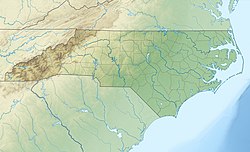Bath, North Carolina | |
|---|---|
| Town of Bath | |
 Bath Creek and Marina | |
 Location of Bath, North Carolina | |
| Coordinates: 35°28′13″N 76°48′43″W / 35.47028°N 76.81194°W | |
| Country | |
| State | |
| County | Beaufort |
| Chartered | March 8, 1705 |
| Named for | Bath, England |
| Government | |
| • Type | Council–Manager |
| • Council | Bath Town Council |
| • Manager | Bubs Carson |
| Area | |
| • Total | 0.92 sq mi (2.37 km2) |
| • Land | 0.36 sq mi (0.92 km2) |
| • Water | 0.56 sq mi (1.45 km2) |
| Elevation | 10 ft (3 m) |
| Population (2020) | |
| • Total | 245 |
| • Density | 686.27/sq mi (264.90/km2) |
| Time zone | UTC-5 (Eastern (EST)) |
| • Summer (DST) | UTC-4 (EDT) |
| ZIP code | 27808 |
| Area code | 252 |
| FIPS code | 37-03840[3] |
| GNIS feature ID | 2405214[2] |
| Website | townofbathnc |
Bath is a town in Beaufort County, North Carolina, United States. Located on the Pamlico River, it developed a trade in naval stores, furs, and tobacco. The population was 249 as of 2010.[4] North Carolina’s first town and port of entry, it was chartered on March 8, 1705.
Historically, Bath is often counted as North Carolina's first capital, as it was nominally so designated in 1712, when the Province of North Carolina was separated from the Province of Carolina and granted its own governor, though no permanent government institutions were located there. The capital was officially moved to Edenton in 1722, but the meetings of the General Assembly would still periodically occur in Bath in the 18th century. Bath was the site of Cary's Rebellion in 1711, and later served as one of many bases for notorious pirate Blackbeard. Bath waned in population, as its importance as both a port and government center were surpassed by the nearby city of New Bern. Bath's population fluctuated through the 20th and 21st centuries, but it has never exceeded 400 residents.
- ^ "ArcGIS REST Services Directory". United States Census Bureau. Retrieved September 20, 2022.
- ^ a b U.S. Geological Survey Geographic Names Information System: Bath, North Carolina
- ^ "U.S. Census website". United States Census Bureau. Retrieved January 31, 2008.
- ^ "Geographic Identifiers: 2010 Demographic Profile Data (G001): Bath town, North Carolina". U.S. Census Bureau, American Factfinder. Archived from the original on February 12, 2020. Retrieved February 5, 2014.


